Causes
Many symptoms are associated with headaches behind the eyes. This headache includes eye pain, redness, excessive tearing, eye dryness, weakness or numbness in the face, vision weakening or double vision, sinus based, and even fever. The basis of these symptoms is diverse and varied. Here are the causes associated with pain behind the eyes.
Dryness of Eyes
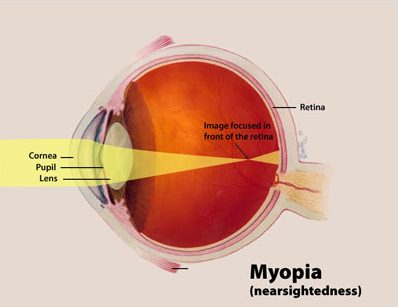 |
| Photo by: National Eye Institute |
The eye becomes dry, and discomfort takes place for those working on computers throughout the day. Itching, sharp pain sensation, and burning can also be the result. Prolonged and extended dryness can lead to a rush of tears in response to irritation. The eye can protect itself from further drying, but you may need artificial tear solutions as well. An eye doctor can prescribe safe medications for this as well. Also called keratitis sicca and sicca syndrome, dry eyes can be a real problem associated with pain behind the eye. Light sensitivity is also manifest in 17 to 30 percent of those suffering from this condition.
Problems in Vision
Vision problems can cause eyestrain and discomfort. Headaches occurring with a variety of eye conditions such as presbyopia, farsightedness, and astigmatism indicate vision problems may be the basis of a headache.
Scleritis
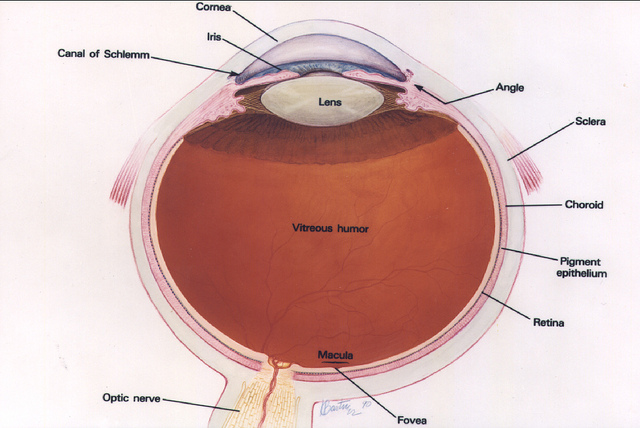 |
| Photo by: National Eye Institute |
A film which is thin and covers the eye’s external surface is known as the sclera. Redness, burning, and painful sensations are felt. Severe cases can even lead to vision loss. Symptoms such as connective tissue diseases and rheumatoid arthritis increase the chances of developing this condition. Excessive pain and redness may also be noticed. Options include NSAID eye drops, steroid eye drops, antibiotics, and even immune-modulating medications such as adalimumab, methotrexate, and others based on the reasons for the pain. Scleritis can result from Scleroderma, Lupus, Rheumatoid Arthritis, and IBS.
Cranial Nerve Palsies
These are multiple never arising from the brain and providing the vision to which one is acclimatized. When these nerves undergo inflammation, injury or compression, vision changes. Specific symptoms include double vision, eyelids drooping, dilation, or change in pupil size and significant pain. Diabetes is a common cause of cranial nerve palsies. Treatment focuses on correcting the underlying causes and ruling out serious causes such as brain tumor or stroke.
Orbital Inflammatory Syndrome
The home of the eye is its orbit. This orbit comprises the nerves, blood vessels, lymphatics, muscles, and fat that move the eyes. Swelling can occur. A CT scan or blood test can diagnose any infection. Support through treatment and anti-inflammatory medications may work. Inflammation treatment is based on the cause. Staring sidewards or touching the eye may cause pain in this case.
Optic Neuritis
This condition is associated with the onset of muscular degenerative diseases like MS. People experience eye pain, numbness, lower visual acuity, and change in color perception. Intense headaches require treatment for pain-alleviation, and steroids work to decrease the swelling.
Tension Headache
This type of headache causes pain or a headache behind the eyes as well. The sensation is band-like and associated with the fatigue of neck muscles or injury and stress. Treatment comprises rest, OTC medication, massage and ice or heat applied to the base or neck of the head.
Migraine
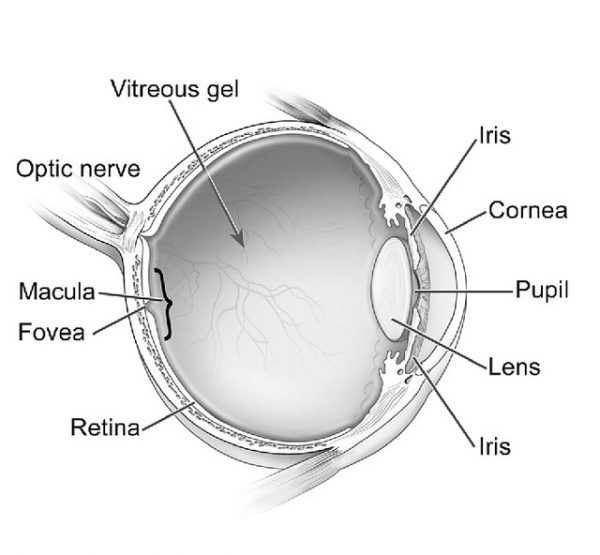 |
| Photo by: National Eye Institute |
Neural changes in the brain cause a migraine. Migraine patients frequently report pain behind the eyes and a headache which throbs and creates intense pain. These headaches affect the individual and can be in the form of an ocular migraine or a full-blown one. An ocular migraine leads to squiggles, flashes, and transient visual obscuration, which may or may not develop into a complete migraine. Numerous options are available for treating migraine, and this includes OTC medications, rest, statins and blood pressure medications, antidepressants, botox, and anti-seizure medication.
Migraine affects 6% of those with headaches. It causes trouble with painful intensity. Migraine headaches are triggered by smells, stress, allergies, and flashing lights. Migraine sufferers experience a headache bout once in a month at least. These headaches are triggered by stress, leading to an allergic reaction most commonly. An ocular migraine is a rare and severe issue affecting one of 200 who suffers from migraines. This pain bothers just one eye of the pair. It is known as a retinal migraine and requires medical attention, which may be the sign of the tumor.
Sinus
There are numerous sinus cavities in the head and face-centered around the eye. Headaches behind the eyes are a sensation accompanying sinus. This condition is caused by allergies and infection. Treating it involves clearing congestion, healing the pain, and using antibiotics to prevent disease. This headache refers to a swelling of the sinus cavity, causing pressure and pain behind the cheek, eyes, or bones. Other symptoms include fatigue, toothaches, fever, nasal blockage, reduced taste, and tenderness of the face. Causes of sinus infection range from allergies to environment, food, or other sensitivities.
Cluster Headache
This causes extreme pain behind one eye. Males experience these headaches more often. Tearing and cyclically recurring problems across many days commonly result. Treatment includes rest and pain medication, and supplemental oxygen is adequate for those suffering from cluster headaches as well. Treating this involves the use of pain medication and rest, Supplemental oxygen also works for those suffering from this headache. Histamine or serotonin release leads to this kind of headache.
Hormone
Fluctuating levels of hormones are associated with headaches. Migraine sufferers report increased pain at the time of menstruation. Hormone dips and rises can lead to chemical transitions in the brain and blood vessels. Specific medications also exert this impact. Hormonal mediated dilating and contracting of blood vessels causes headaches.
Aneurysm
This is another cause of pain behind the left eye. This aneurysm takes place when an artery wall or blood vessel in the brain weakens. This causes a stroke or bleeding leading to pain and a throbbing headache.
Glaucoma
This condition causes vision loss. The reason for this is intraocular pressure, which occurs when one eye builds and causes damage. Other glaucoma symptoms include nutritional deficiencies, hypertension, diabetes, and prescription drugs. Throbbing eye pain is a possible indication of glaucoma.
Treatment
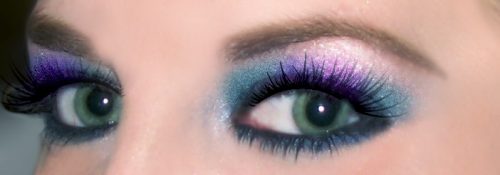 |
| Photo by: National Eye Institute |
To assess the best treatment method, a complete assessment of the symptoms is a must. Once the cause is discovered, the course of treatment generally revolves around medication, diet, rest, and careful lifestyle choices. If these remedies do not provide relief from the pain, consulting with the medical professional is critical for complete diagnosis and treatment.
For Migraines
Treatment for migraines is possible only if this condition has been diagnosed. Common symptoms include light sensitivity, nausea, vomiting, confusion, throbbing headache on front and sides of head and numbness. Ophthalmoplegic migraines (also known as ocular migraines) cause complete vision loss and intermittent ones at that too. Migraines can completely wreck the functionality of an individual. Treatment for migraine headaches involves OTC medicines like Ibuprofen, Tylenol, and getting sleep in cold, quiet rooms or eating meals to prevent a migraine caused by insulin. Drinking black tea or coffee, ice packs, relaxing massages, BP medicines, antidepressants, and supplementation, as well as botox, are some of the other treatment types.
For Cluster Headaches
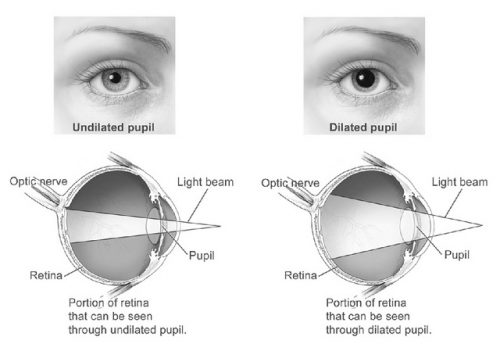 |
| Photo by: National Eye Institute |
These occur in a cyclical pattern and linger for some days at the same time. Those with a familial history of cluster headaches, and members who are males suffer this condition more. Common symptoms include watering eyes, red nose, and pain centered on one particular eye. Treatment includes pain medication and getting plenty of rest. Supplemental oxygen helps to lessen pain by constricting blood vessels to open out and loosen. OTC medication cannot treat this headache. You need pain medication like sumatriptan to prevent this condition.
For Sinus
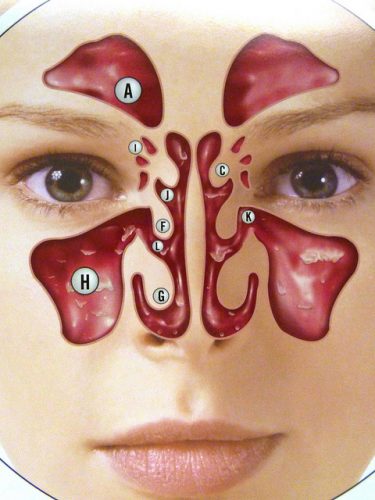 |
| Photo by: National Eye Institute |
For treating sinus, reduction of pressure and congestion along with treatment of existing infections through antibiotics is a must. Conventional methods of decongesting the nose include neti pot and saline nasal spray. This can prevent the sinus from recurring. Steam can also work to clear the congestion.
For Vision Problems
Long-sightedness can occur as individuals are not able to see objects at a distance clearly. This involves correction by choosing to see a vision specialist or eye doctor and getting a prescription for glasses or contact lenses.
For Dry Eye Syndrome
For treating this, long stretches at the computer screen or TV must not be carried out. Sitting too close to these objects is also not a good idea. Apart from prevention, artificial tears or eye drops recommended by the doctor can also be used. Hydrating the tissues of the eye and using prescription medication for extreme conditions is a must.
For Astigmatism
For this, individuals developing headaches on account of irregular eye shape of the retina need to be fixed. The condition causes a headache behind the eyes as a result of not being able to view the objects in clarity. Visiting an eye specialist is a must.
For Orbital Inflammatory Syndrome
A CT scan and blood tests confirm the presence of the disease and can be checked for infections. Orbital inflammatory syndromes can be very intense, and treatment involves OTC meds like ibuprofen.
For Scleritis
For this, an eye professional must be consulted if extreme eye redness and pain cause vision loss. Antibiotics and steroid, as well as non-steroid eye drops, are used for treating medications such as Humira or methotrexate.
For Optic Neuritis
This inflammatory condition is treated using steroids to reduce the pain and the swelling around the eyes.
For Cranial Nerve Palsies
This condition results from injury, swelling, or compression of cranial nerves and can lead to a change in vision. This causes the blood supply to the eyes to become less efficient and is caused due to conditions like diabetes. Professional diagnosis to check if there is tumor or stroke is essential. It is crucial to resolve the underlying cause of the problem.
For Tension Headache
A common type, tension headaches result from bad posture, inadequate hydration, and missing meals. This is caused by overuse or injury of the neck and fatigue that results. It is common to go away on its own. But painkiller medications like paracetamol can also work wonders.
For Hormone Fluctuations
These are closely associated with headaches in women and severe manifestations during the menstrual cycle. Along with menstruation, menopause, and specific medications and contraceptive pills can also bring on headaches. Blood vessels in the eye can be impacted by mediated dilation leading to headaches too. So exercise is the best way to counter this because the brain releases painkilling medication during this phase.
For Migraine
Rest as well as sleep are the critical steps in curing migraine. Blood sugar dips and spikes need to be prevented. Apart from OTC, prescription medications and ice packs, massages and supplements may also be prescribed.
Diet and Exercise
Decreasing or alleviating headaches involve the use of massage therapy, chiropractors, and even acupuncture or relaxation, for instance. Additional treatments include manual exercises. OCT, anti-inflammatory, and steroid medications may be used. Equally important are diet and exercise factors.
Physical Exercise
This is because a headache behind the eyes is tackled by endorphins, natural painkillers in the body following exercise. This causes pain relief like morphine. Exercise such as yoga also calms the nervous system and reduces anxiety, erasing pain due to migraine or tension headaches.
Avoid Triggers
Alcohol, tobacco, and rich goods that negatively affect circulation and cause problems and are containing sodium or preservatives like MSG, nitrates, and others can increase tension and make headaches severe. Food colors, processed, and frozen foods are a no-no as well.
Eat Nutrients and Supplements
5-HTP is a natural painkiller for a headache behind the eyes, and it can reduce tension and migraine headaches too. Studies have shown this supplement can prove as beneficial as coenzyme Q10 in reducing headache behind the eyes. Magnesium-rich foods and supplements can also work wonders. It works for treating migraines, glaucoma, and inflammations caused by tension. Low glycemic diets can also work well. This includes nutrient-rich foods like cabbage, cauliflower, collard greens, Brussel's sprouts, and broccoli. For any headache related issue, you may check the West12 Health Centre for any help.

0Comments